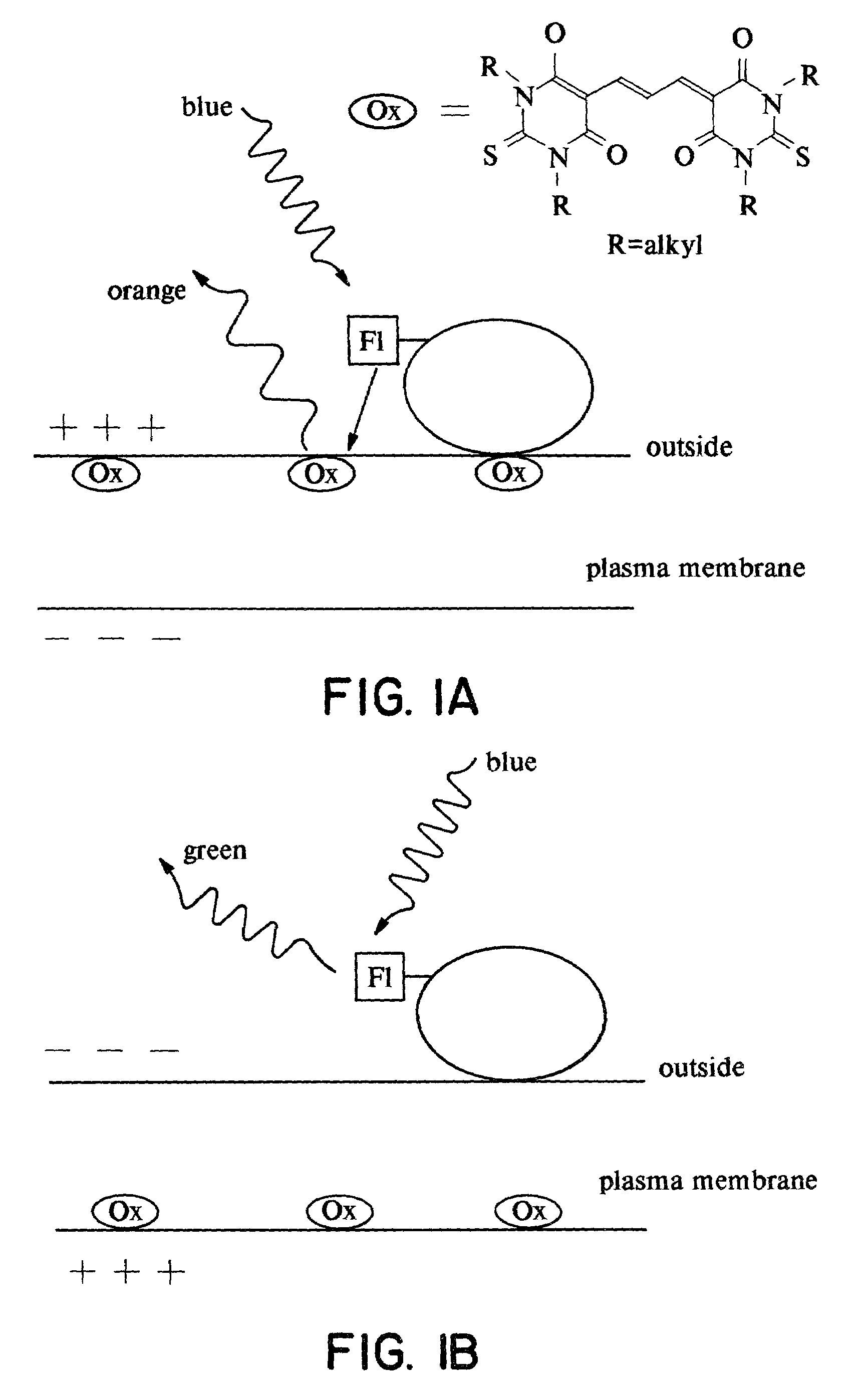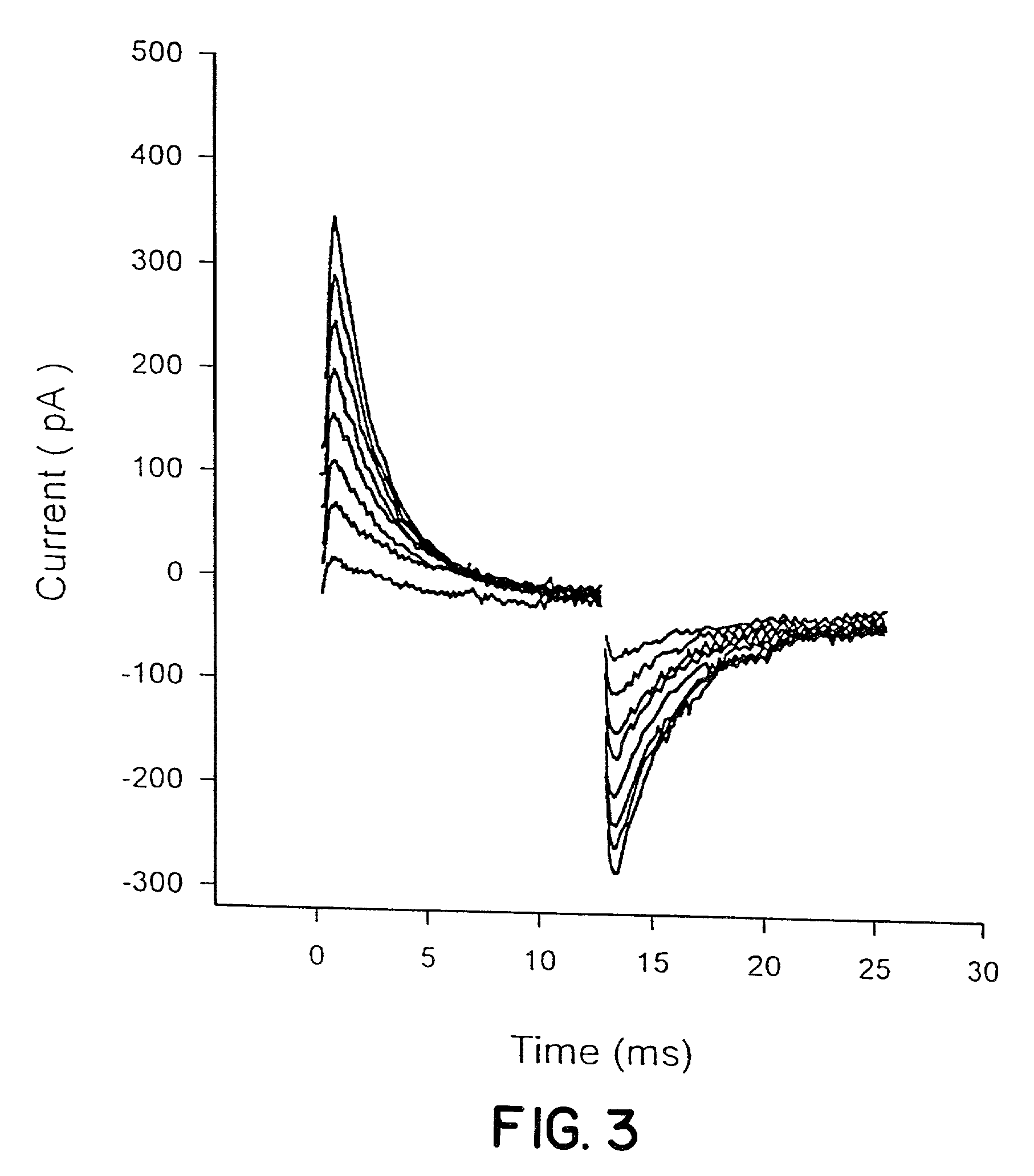Detection of transmembrane potentials by optical methods
a transmembrane potential and optical method technology, applied in the field of compositions and optical methods, can solve the problems of inability to give any shift in fluorescence wavelengths or ratiometric output of indicators, slow response of indicators, and difficult selectivity between cell types, etc., to achieve the effect of simple and convenien
- Summary
- Abstract
- Description
- Claims
- Application Information
AI Technical Summary
Benefits of technology
Problems solved by technology
Method used
Image
Examples
example i
Synthesis of Oxonol Dyes
[0313]All starting materials and reagents were of the highest purity available (Aldrich; Milwaukee, Wis.) and used without further purification, except where noted. Solvents were HPLC grade (Fisher) and were dried over activated molecular sieves 3Å. NMR spectra were acquired on a Varian Gemini 200 MHz spectrometer (Palo Alto, Calif.). The spectra were referenced relative to the residual solvent peak (CHCl3, =7.24 ppm). Fluorescence spectra were taken on a SPEX Fluorolog-2 (Edison, N.J.) and were corrected for lamp and detector wavelength variations using the manufacturer supplied correction files.
Bis-(1,3-dibutyl-2-thiobarbiturate)-trimethineoxonol DiSBA-C4-(3)
[0314]DiSBA-C4-(3) was synthesized based on the procedure for the ethyl derivative [British Patent 1,231,884]. 1,3-di-butyl-thiobarbiturate (500 mg, 2 mmol) was dissolved in 700 μL of pyridine. To this solution, a mixture of 181 μL (1.1 mmol) of malonaldehyde bis(dimethyl acetal) and 100 μL of 1 M HCl w...
example ii
Synthesis of Fluorescent Phospholipids
[0318]Cou-PE: 3-amidoglycine-6-chloro-7-butyryloxy coumarin was synthesized as described in pending U.S. patent application, Ser. No. 08 / 407,554, filed Mar. 20, 1995 as set out below. For synthesis of 2,4 dihydroxy-5-chlorobenzaldehyde, 21.7 g (0.15 Mol) 4-chlororesorcinol were dissolved in 150 ml dry diethyl ether and 27 g finely powdered zinc (II) cyanide and 0.5 g potassium chloride were added with stirring. The suspension was cooled on ice. A strong stream of hydrogen chloride gas was blown into the solution with vigorous stirring. After approximately 30 minutes the reactants were dissolved. The addition of hydrogen chloride gas was continued until it stopped being absorbed in the ether solution (approx. 1 hour). During this time a precipitate formed. The suspension was stirred for one additional hour on ice. Then the solid was let to settle. The ethereal solution was poured from the solid. The solid was treated with 100 g of ice and heated ...
example iii
Synthesis of Linker for Donors and Acceptors
[0325]This example is with reference to FIGS. 14–16.
[0326]12-p-methoxybenzylthio-1-dodecanol (1): Na (800 mg, 34.8 mmol) was dissolved in 30 mL of dry MeOH. Under argon, p-methoxybenzylmercaptan (2.75 mL, 3.04 g, 19.7 mmol) was added to the methoxide solution. After a few minutes, 12-bromododecanol (2.5 g, 9.43 mmol) was dropped into the reaction mixture. Within 5 minutes a solid began to come out of solution. After a minimum of 3 h, the reaction was filtered and washed 3× with cold MeOH, yielding 2.874 g (8.49 mmol, 90%) of pure product after drying. 1H NMR (CDCl3): d 7.23 (d, J=8.8 Hz, 2H, AA′ of AA′ BB′ aromatic system), 6.85 (d, J=8.8 Hz, 2H, BB′ of AA′ BB′ aromatic system), 3.80 (s, 3H, methoxy), 3.66 (s, 2H, benzyl), 3.64 (dt, J1=6.6 Hz, J2=5.5 Hz, 2H, RCH2OH), 2.40 (t, J=7.3 Hz, 2H, RSCH2R), 1.50–1.65 (cm, 4H, CH2 b to heteroatoms), 1.2–1.4 (cm, 16H, bulk methylenes).
[0327]12-p-methoxybenzylthio-1-bromododecane (2): (1) (500 mg, 1.4...
PUM
| Property | Measurement | Unit |
|---|---|---|
| resting membrane potential | aaaaa | aaaaa |
| resting membrane potential | aaaaa | aaaaa |
| time | aaaaa | aaaaa |
Abstract
Description
Claims
Application Information
 Login to View More
Login to View More - R&D
- Intellectual Property
- Life Sciences
- Materials
- Tech Scout
- Unparalleled Data Quality
- Higher Quality Content
- 60% Fewer Hallucinations
Browse by: Latest US Patents, China's latest patents, Technical Efficacy Thesaurus, Application Domain, Technology Topic, Popular Technical Reports.
© 2025 PatSnap. All rights reserved.Legal|Privacy policy|Modern Slavery Act Transparency Statement|Sitemap|About US| Contact US: help@patsnap.com



